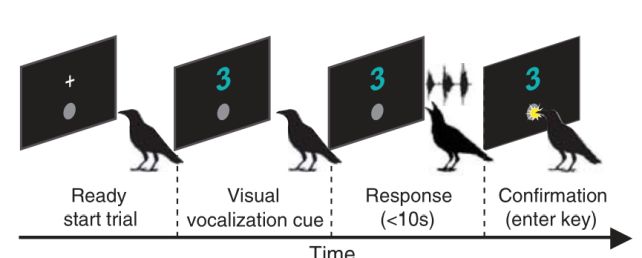[ad_1]
The study reveals that crows can “count” out loud, emitting a specific number of caws in response to visual or auditory stimuli. Although their counts were not always accurate during the experiments, their performance could be compared to that of young children learning to count.
This demonstrates an amazing vocal and numerical planning ability previously thought to be specific to humans.
In humans, the control of learned vocalization (or the production of sounds through the voice) is one of the essential aspects of the evolution and learning of speech (or vocalized language).
This control allows, among other things, the planning and production of context-specific combinations of sounds, such as for example counting. Studies have shown that some (non-human) animals also have the ability to count by controlling the number of screams they produce.
Songbirds, in particular, provide excellent models for studying the neurocognitive mechanisms underlying the control of learned vocalization. Although birds are relatively distant from humans from an evolutionary point of view, learning to sing in these animals has many similarities to our learning to speak.
Like us, birds, for example, need to listen to adults and learn from them during a critical period of their development. This process is followed by rigorous training until the vocalization of an adult is perfectly imitated.
Show a strong climate message 🌍
However, the ability of birds to digitally control their vocalizations has so far lacked reliable evidence. For example, one study showed that among black-capped arboreals (Poecile atricapillus), the number of “D” characters at the end of the alarm is inversely correlated with the size of the predator against which the warning is issued.
However, this does not necessarily prove that they are deliberately controlling the number of calls or notes they make. It is possible that the tone of the song reflects a state of arousal proportional to the danger of the predator.
As part of a new study, published in the journal: Science, researchers from the University of Tübingen (in Germany) show that crows have a counting ability comparable to that of small children.
They kind of plan and count their votes in a contextual way. ” We believe this is the first time this has been demonstrated for an animal species (except for people),” he explains Scientific American Diana Liao, postdoctoral researcher in neurobiology at the University of Tübingen and co-leader of the research.
Performance comparable to that of young children
As part of their experiment, German researchers selected three black crows (Corvus corona) to perform various tasks. Belonging to the group of songbirds, they are known for their incredible intelligence and ability to precisely control their voice.
For example, a previous study showed that they understand counting and can precisely control whether or not they want to perform a certain type of croaking.
Birds were asked to observe a selection of 4 colored numbers or listen to 4 specific sounds (short guitar chords and drumming), then caw one to four times, depending on the appropriate stimulus.
Specifically, the cues were presented randomly, and the birds had to determine how many calls to associate with each, through a process of trial and error.
If they succeeded, they were entitled to a prize that they clicked on the “Enter” key (to confirm the answer).

After 166 to 189 cycles of trial and error, three crows were able to produce the number of caws corresponding to each stimulus. The researchers also suggest that they could master numbers greater than 4 if given the chance.
On the other hand, the response time was relatively long as the number of required grunts became high, regardless of the nature of the stimulus. According to Andreas Niederwho led the study, “this suggests that from the information presented to them, crows form an abstract numerical concept that they use to plan their vocalizations before emitting the call.”
Analyzing birdsong, the researchers also found that it was possible to predict the number of croaks from the pitch of the first one. However, their counts were not completely error-free. ” Counting errors, such as one too many or too few calls, occurred when the bird lost track of calls already made or about to be made Nieder explains. These errors can also be traced in the acoustic properties of individual cuckoos.
Also note that birds cannot literally count like adults (or those old enough to master numbers), but like small children who have not yet mastered symbolic counting. For example, to refer to three objects, a child might say “one, one, one” or “one, two, three,” instead of just “three.” The number of emitted sounds thus corresponds to the number of objects.
On the other hand, the results are relatively predictable given the exceptional cognitive abilities that characterize crows (belonging to the same family as crows) in general. Previous research has, for example, shown that they can
master probabilities and understood the concept
recursion (a process whose description leads to repetition of the same rule). However, their evolutionary trajectories seem to indicate that these abilities are mutually exclusive and may therefore represent a surprising case of convergent brain evolution.
source: Science
[ad_2]

